Minnie Royal/Royal Lee cherries in SoCal. Worth the effort?
I have seen where some people who had planted minnie royal and royal lee low chill cherries were very unhappy with fruit yield. They were getting just a hand full of cherries and bloom times for both trees were staggered.
Is there anyone who has these trees with some time in the ground who is happy with their harvest? I am in inland southern California. Very hot summers and mild winters with 100-300 chill hours.
Comments (69)
Parker Turtle
6 years agolast modified: 6 years agoCarol, you do realize that with low chill cherries in warm climate areas you need to give them at least 4 years in the ground?
Cherry trees don't immediately start producing and this is especially true when the amount of chill relative to what the tree requires is borderline.
Also, in hot climates a cherry tree in full sun is not going to grow well, so that's going to set back growth even further. I'd at least put it in partial shade for the first two years.
A warm sunny day can really detract from the amount of effective chill a cherry tree accumulates during the Winter in somewhere like Texas if it's out in the open with absolutely no shade.
Diyfreddy
6 years agolast modified: 6 years agoI have Royal lee, Minnie royal and crimson royal in sunset 23. Crimson royal looks great but is still small and under a year in the ground. My other two bum trees are growing but no fruit set and the graft sites aren’t looking too healthy either. Just saw a Minnie royal at Home Depot today and has me thinking about buying and planting it as a back up.
Related Professionals
Tomball Landscape Architects & Landscape Designers · Alexandria Landscape Contractors · Columbine Landscape Contractors · Dallas Landscape Contractors · Fairhope Landscape Contractors · Harrisburg Landscape Contractors · Inglewood Landscape Contractors · Mastic Beach Landscape Contractors · Quincy Landscape Contractors · River Ridge Landscape Contractors · West Haverstraw Landscape Contractors · White Bear Lake Landscape Contractors · Wilsonville Landscape Contractors · Suisun City Landscape Contractors · Bensenville Landscape ContractorsJames
5 years agolast modified: 5 years agoLessons learned so far from Southern California cherries:
-Plant in sandy (or loamy) well-drained soil. Definitely no clay. Definitely no organic amendments
-Plant high. Stick it on the ground and add dirt around that. Slight exaggeration but plant high.
-Prune not to let light in, but to cast shade. Specifically head low the first year so it has low branching. Don't let branches get leggy or a) the branch will sunburn and b) nothing will grow lower. Get that ground shaded
-Mulch to keep the roots from being burned. Walk in your orchard in bare feet anywhere San Diego inland and the ground is 130 degrees of more. The bare ground is often 40 degrees hotter than the air, and the air was as high as 113 last summer, inland. Studies show double the growth rate in our climate from thick mulch. Yes, mulch is fertilizer. It may also minimize those winter temperature swings on those random January 85 degree days. Keeps the ground cold. But the main thing is preventing 150 degree ground in July.
-Don't water near the trunk. I know that is obvious. Many stone fruit let you get away with that. Seems that cherries do not. Water at the perimeter. I think we should water weekly.
-Newroot-1 is a terrible rootstock, your tree dies and all it does is sucker. Fortunately Dave Wilson does not seem to be selling it much any more. If you failed on Newroot-1, try again on Maxma 14. High heat stops growth. Southern California needs standard rootstocks in general. I am experimenting with Gisela 6 and it is too early to call but I actually think Maxma 14 may be my new favorite.
-When the tips of branches turn black, that is oriental fruit moth. Use BT to control it. If you want to be sure, take out a pocket knife and cut the tip of the shoot longitudinally, and you will see how the larvae ate the inside out, like a kid who eats the white of oreos and then sticks the oreo back together and puts it back in the package.
-There are 6 varieties thought to do well in low chill areas. The new ones from Zaiger (Royal Crimson, Minnie Royal, Royal Lee). Laguna Hills nursery raves about Lapins, and Stella can work okay. Don't knock Pacific Groves/Home Depot, they do more for low chill cherries than anyone. Their self-fertile Bing is actually Lapins. Buy it and try it. Finally, Cristobalina is known in Spain and promoted by Arboreumco. Cristobalina is described as the lowest chill cherry in many studies. It needs to start showing up at scion exchanges. Try all 6 and let's figure this out.
Kevin Reilly
5 years agoMulch doesn’t have to be fertilizer, rock mulch and pine straw would be good choices if looking to avoid organic decomposing
dretutz
5 years agoHave any of you tried the Pluerry? Cross between plum and cherry; got mine at Laguna Hills Nursery. Gary says it needs a plum to pollinate. I planted with a Burgundy plum. We'll see.
socalnolympia
5 years agolast modified: 5 years agoI tried planting Lapins two different times in a remote area and made sure to give it some water a few times during the hot dry Summers. Both of them slowly declined and eventually died. The trees just lacked the vigor needed to thrive because they were not getting adequate chill. (zone 10, Southern California, not too far away from the ocean)
I don't think Lapins is going to be able to survive long-term in this climate unless it gets a lot of care and is kept consistently watered throughout the hotter half of the year.
It's definitely not going to thrive or vigorously grow in the first two years.
Surprisingly I have a Bing that has grown well and, after the first two years, even thrived, although it has never fruited and the occasional year it has blossoms it only has a just a small number. (It was on standard rootstock)
Later I decided to try grafting a branch of Royal Minnie into it, which has since done okay. It even formed a few little underformed cherry druplets one year, but they either dropped off or the birds got to them before they could form mature fruits.
There are two Royal Lee and two other Royal Minnie which are still surviving (maybe very slowly growing) but are not doing really well. They obviously seem to be lacking vigor and haven't put out that many leaves.
They seem to prefer shadier spots with part sun in this climate, but even in those spots they haven't grown very well for me.
I even tried a Rainier in a large container, which did fairly well for a year or two (put out a fair number of blossoms) and then died.
(same person parker25mv, just new user name)
HU-111905664
5 years agosocalnolympia does that mean we're out of options. I was hoping I could plant a cherry in a land I have in semi arid north Africa on the mediterranean... After reading your experience, I feel like it's not even worth trying...
socalnolympia
5 years agolast modified: 5 years agoI would go with Royal Lee / Royal Minnie Lee, and see if you can plant your cherry trees under the partial shade of a tree (or use a shade cloth structure to protect them while young). You absolutely need to be consistently giving them water in the Summer. (Royal Crimson is another varitety that was recently developed in California, and is like Royal Lee but self-fertile, i.e. you don't need a separate pollinator to get fruit)
Out in Spain, Cristobalina is another heirloom variety.
The most important time to provide shade and cool temperatures are Summer and Winter. Winter because that's when the plant is accumulating chill hours, and Summer because that's when the leaves will struggle in the blazing hot dry sun the most.
socalnolympia
5 years agolast modified: 5 years agoThe Minnie Royal (in a large container, in the shade) is still alive, and full of blooms now. It was a colder Winter than usual.

Southern California, solid zone 10
Go back, I also posted pictures of the same tree dated April 7, 2017 in this thread.HU-111905664
5 years agoThank you so much for the updates! I'm gonna certainly look into Royal Crimson. Reading your comments gives me a lot of hope. You should try a Royal Crimson tree yourself :)
socalnolympia
5 years agoI also have experience growing cherries (both fruiting and ornamental types) in a different climate with a lot of chill, and can tell you there's a world of difference how fast and vigorous they grow when they get lots of chill accumulation.
When the tree's lack vigor, the initial leaf growth is very small, the first flush of leaves may never get very big. Blossoms, if they do form, may not have enough energy to form fruits, or if fruits do form they may prematurely drop from lack of vigor. More than a year of that and the tree will gradually decline. Dwarfing rootstock will help make the tree more prone to fruit formation anyway, but it will also make the tree more likely to decline when it doesn't have enough vigor, i.e. it might only make it 2 years before it is dead. These are just some general observations from a lot of personal experimentation. Giving it modemoderate to partial shade in the Winter can help compensate for lack of chill. (Warm sunny days can detract from chill accumulation over the Winter)
HU-111905664
5 years agohttps://en.excelentesprecios.com/cristobalina-cherry
Is it impossible to get a Cristabolina in the US? SMS Unlimited seems to be based in California. I would like to take a low chill tree with me next time I travel, and it would be nice if I don't stop by Spain for it :)
Otherwise, are you aware of a good rootstock that I could start from a seed?Diyfreddy
5 years agolast modified: 5 years agoI have Minnie royal and royal lee flowering in sync now but crimson royal who is meant to pollinate both is not flowering yet haha SoCal zone22
HU-697401058
5 years agolast modified: 5 years agoin February 2013, I purchased a 22 inch crate with a Minnie Royal and Royal Lee both in the crate. The Minnie Royal was about seven or 8 feet tall and the Royal Lee was maybe 5 feet and small and spindly. 2013 was a fairly cold winter. I live in the foothills west of Altadena, California at about 1300 feet elevation. I am in USDA zone 9B and Sunset magazine zone 21. I live on a slope, not Valley or basin. The soil untreated is clay like and decomposing granite. In other words, pretty bad. I dug a hole 5 feet wide and 4 feet deep in the front lawn, put a lot of amendment, and planted this thing. Because of the cold winter, the trees slept pretty well. The Minnie Royal clearly bloomed first and the Royal Lee much later but with some minor overlap. We got about 75 cherries. In 2014, 2015 and 2016, the winters had warm and cold spells. For example, it would get cold in the fall but then we would get Santa Anna winds that would Jack the temperatures up into the 70s, 80s and even 90. Whenever we had a lot of up and down in the temperatures, it would cause the Minnie Royal to bloom much earlier, and the Royal Lee much later. During those three years, we had negligible cherry crops, but the trees would grow very well. The Royal Lee stayed small and spindly and there were a lot of branches growing at right above the graft. People told me to get rid of those but I didn't. Because of those low branches, the Royal Lee started looking more like a bush. In 2017 i.e. the winter of 2016/2017, we had a lot of rain and a long contiguous spell without Santa Ana wind heat waves. That year, we noticed a few things. Both trees flower from the bottom branches going upwards. Because of those very low branches on the Royal Lee, the ones just above the graft, and the flowering from bottom upwards tendency, it was those low branches that flowered at the same time as the Minnie Royal. During that year, the Royal Lee was about 12 feet tall and the Minnie Royal about 20 feet tall and 15 feet wide. We had probably 750 cherries. And they were the best. Very juicy, incredible. In 2018, I think the entire commercial crop suffered from the very dry and warm winter. Things got cold in the fall and it was looking good. Then in late December through February, 70s and 80s were the norm. The Minnie Royal started to wake up in February which was way too early. And then with the Minnie Royal half flowered, in March, winter hit with a vengeance with rain and cold temperatures. To make a long story short, there were about five cherries which the birds got. This winter of 2018/2019 was amazing. Very wet and a very contiguous cold spell. This was the first time since record-keeping began that downtown Los Angeles never hit 70 in the month of February. It was cold through December, January, February and even March. What happened next was stunning. Both the Minnie Royal and Royal Lee flowered in sync. Believe it or not, the Royal Lee first and Minnie Royal almost immediately thereafter. Both trees looked like those cherry trees in Japan and in Washington DC except the flowers were white, not pink. I've never seen the trees like this before. Totally white. Next, the big surprise. I have a 50 – 60% fruit set on that ton of flowers. While the cherries are not turning red yet, the tree literally looks like a commercial tree, or like the ones pictured in the Dave Wilson catalog. In summary, I think weather has very much to do with the success or failure in a particular year. Long contiguous cool/cold spells are great, and when you have two or three week duration Santa Anna winds with resulting 80° temperatures, not so good. Tactically, I think keeping the low branches on the Royal Lee was a good thing. Because it flowers later but flowers from the bottom upwards, it is those low branches that are better in sync with the Minnie Royal. Another note. It was 118° on that Friday, I think it was July 6, 2018. On that day, and others in the hundreds, I did go outside and spray the entire tree from time to time. I remember on that day, a lot of trees in the neighborhood dropped their leaves like it was autumn but the leaves were green and crunchy. That didn't happen to my Minnie Royal/Royal Lee. As for fertilizer, I use very generic four – four – four and not too much of it. In summary, I think it is worth it and it is definitely a gardeners hobby. If you think you can just plant Minnie Royal and Royal Lee cherries like you could plant a lemon tree and think everything will happen by itself, it won't. I deep water once a week, and really take care of these things. It's a hobby. Like planting a papaya in a climate it is not suited for, or like planting a rhododendron and then making it a part of your lifestyle to keep it alive and actually make it bloom. If you take that approach and are proactive, when the weather cooperates you will have great crops. Don't expect it every year.
HU-111905664
5 years agoThis was certainly pleasing to read. Now just imagine with me what a self fertile low chill cherry tree could do :)
HU-697401058
5 years agoIf you look closely, you'll see the Minnie Royal is in the front and Royal Lee in the back, closer to the house. And you can see those very low flowers close to the ground are from the Royal Lee. In the other picture, I took a picture at night of a portion of one of the branches. Right now, the whole tree looks like that picture except now the blooms are gone. There's got to be a couple thousand cherries up there. I think the weather had everything to do with it.
HU-697401058
4 years agoMay 8 Update, getting really close to being ready. Relatively few birdstrikes. Oops- just saw a bird, got to run and chase it away. This is the year of all years. Makes up for those years with warm, dry winters. Both the Minnie Royal and Royal Lee have a lot of fruit.
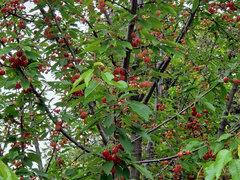
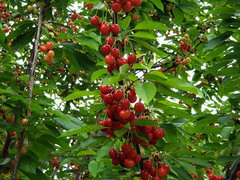
fireballsocal
Original Author4 years agoWow HU, that looks fantastic! What a harvest! I have cherries for the first time on my Minnie Royal. 4 of the little guys. I've eaten 2 and the cherries were good if a little tart. I didn't leave them on the tree very long after turning red in case the birds went after them. I have 2 more left on to ripen a little longer.
Diyfreddy
4 years agoI’m jelly over here. My royal lee dropped all its pea sized fruit. Minnie royal didn’t set any and crimson royal didn’t bother to flower.
socalnolympia
4 years agofirst real red fruit on Royal Minnie
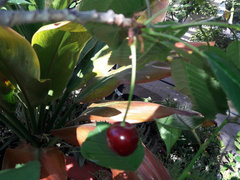
in mostly shade, tree in a large container, zone 10, it was a colder Winter than usual this year
Also a note about the other Royal Minnie grafted onto Bing. Apparently it's doing well, but the experiment showed that a low chill graft waking up will not necessarily wake up the rest of the tree. Lots of big leaves and vigorous growth on the top, but no leaves on the lower Bing part of the tree.HU-697401058
4 years agolast modified: 4 years agoMay 20 update-- Incredible harvest this year. Had some birdstrikes but minimal. Some years good, some bad, nothing like this one before. We're getting two large heaping bowls of cherries per day. Giving to neighbors, eating too many, my son made a pie. Next year - who knows - could be 20, could be 2000. A lot of great fun when the weather is optimal and everything lines up. Try to do everything the tree needs and with luck it happens. Again, I'm in the foorhills not too far from Altadena/La Canada/La Cresenta at about 1300ft, Sunset zone 21, USDA Zone 9B.
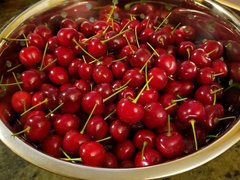
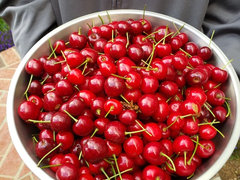
Today's at top, yesterday's at bottom. All Minnie Royal. Royal Lee is loaded but slower to ripen. They'll be next week.
HU-834461811
4 years agolast modified: 4 years agoMy story is identical to the one above. We have had one each of the trees (Minnie Royal/Royal Lee) planted together (literally we were told to put the trunks next to each other in the same hole). We live in Pasadena and have had the trees about 9 years. We would get 6 cherries in a good year and often none when the trees bloomed in series. But this year has been crazy. The bloom was the best we had ever seen, picture perfect, and the trees bloomed simultaneously. We picked 8 pounds of cherries this weekend - pies, jam, freezer - and there are more out there for next weekend. My problem is that I have forgotten which tree is which. One is large, tall, and strong and the other spindly and bent over. We had assumed the difference was because we mistakenly oriented them north/south so the southern tree blocks the light for the northern tree, but maybe the trees just have a different demeanor. Last year we talked about cutting down the small one because we didn't get many cherries anyway, but this winter has changed everything. This kind of harvest may not happen regularly, but when it does it is amazing!
HU-697401058
4 years agoHU-834461811,
The Minnie Royal has smaller leaves with the edges of the leaves more jagged. Leaves not flat, more like a boat-hull shape. The Royal Lee has larger flatter leaves. Looks like they are shaped like longboard-surfboards. Edges not as jagged. Smoother shinier leaves if this helps. Royal Lee fruit is generally larger than Minnie Royal and more heart-shaped. In my case, the Minnie Royal is the large tree and the Royal Lee the smaller spindly one.
If you get rid of one of the trees, you'll have great flowers but will need to go to Gelson's to get cherries. You must keep both.HU-834461811
4 years agoThanks. The idea was to identify which variety was the one in the shade of the bigger tree and then buy another one and plant it separately in the yard where it can get its own sun. Then we could remove the smaller one that is struggling. I would probably wait a few years before removing the shaded tree to make sure the new one is doing well and give it time to mature. I am pretty patient with my garden and I am adverse to removing healthy trees, but my fear is that the small scraggly one might die on its own so I would like to be proactive in replacing it. Thanks so much. Your descriptions have really put my situation in perspective and it seems like these trees have very similar behavior in most gardens and are primarily reliant on the weather pattern each winter.
jbclem
4 years agoWhat's wrong with the squirrels in the Altadena/LaCanada hills? Don't they like cherries...
HU-697401058
4 years agojbclem - Funny that you mention that. Two years ago when we had a good crop, there was a squirrel problem. This year, and the crop was quadruple the size, no squirrels at all. Then I noticed the general absence of squirrels in my neighborhood. Of note, I've seen an increase of Red-tailed hawks and have seen several squirrels carried away (despite the loud noise of my applause), an increase of owls, an increase in the number of Bobcats and Coyotes, and our neighbor moved in with a couple of cats. All good. This year, we had so many cherries, we didn't notice what the birds took. At the very end of the season, after we took in 2/3rds of the cherries, and they were purplish-black, almost too ripe, the cherry fruit-fly moved in. You'd see these little pin-holes that would squirt if you held the cherry firmly. If you open the cherry, there is a little pinhead-size maggot. Thankfully this came at the end. We probably harvested 75lbs over a month and left maybe 25-30lb on the tree. A lot of which were too high and the higher-ups more bird-stricken. And again, later on, the fly. All in all, I'm still speechless over the incredible year we just had.
sautesmom Sacramento
4 years agoNo, cherry fruit fly is a different pest, and can destroy cherry tree crops forever once they move in. Almost impossible to stop.
Lazaro Garcia
3 years ago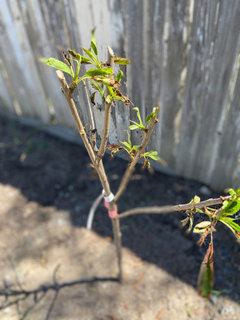
Planted this bare root Minnie royal about 4 months ago. It started off great beautiful leaves n growth., but now it looks like this and I’m not too happy! HELP!
jbclem
3 years agoIt's hard to tell, but it looks like peach leaf curl. Do that infect cherry trees? This was an unusually wet spring here in S. Calif, and I only sprayed a few peach trees with horticultural fine oil. Some trees that normally don't get it are loaded with it right now. All I can do it pick off the infected leaves and hope new ones will grow back un-infected. Next winter is the time to spray oil/copper on your tree before the buds swell.
Steven Gwynne
3 years agoI live near LAX about 3 miles from the ocean. I doubt we get more than 50 chilling hours a year. I purchased a Minnie Royal and Royal Lee about 5 years ago and planted them about 5 feet apart in the sun. The Royal Lee grew quite vigorously, the Royal Lee less so. The 2nd year they bloomed asynchronously but with just enough over lap to get some little cherries. During the 3rd year, the Minnie Royal died, and I replaced it in the fall with another Minnie Royal which sprang to life in spring of the 4th year. No flowers, but it easily doubled in size over the season, going from a 3ft twig to 7 foot tree. This year, the 5th year in this experiment, the two trees are blooming-- asynchronously, BUT the new Minnie Royal is full of fruit! The Royal Lee, which is now about 12 foot tall, is still blossoming on the lower half. The upper half is only beginning.
James
3 years agoHi Lazaro,
The natural environment of the cherry is a European deciduous forest. As a result, they are adapted to well-aerated, well-draining soil, where the roots are reasonably cool. We get none of that in southern California. Our soil does not hold air well. Although the leaves breathe CO2, the roots actually respire oxygen, the same way people do. Your roots are probably suffocating. I killed a lot of trees before I learned this lesson. Here is how to make the cherries feel like they are home:-Plant in a mound above the ground
-This mound should be well draining. You can do that with sand, pumice, perlite, mixed with peat moss and your natural soil. I did 1/3 pumice, 1/3 peat moss, 1/3 natural soil. It is essential you mix natural soil so that the roots don't feel too much of a sharp transition, and so that water flows freely between the layers.
-Have thick compost above the soil. Don't plant in compost and don't mix compost into your planting, but it goes on top.
-On top of the compost goes thick mulch. I literally use about a foot of mulch. Not against the trunk but farther out. Since you are planting so high, 1 foot of compost a foot or more from the trunk is level with your planting. This years mulch is next years compost, on the bottom. Critters "process" that.
-Water fairly frequently around the perimeter of the plant. Cherries thrive in areas that get summer rain.
I hope that helps. The best source of information on best practices is Gary Matsuoka at Laguna Hills Nursery, he has a youtube channel of his talks. His website links to handouts. I stopped killing plants when I started following his information.James
3 years agoHi Steven,
We all see the same thing with Royal Lee. The cherries are not perfectly suited here. It is true that Royal Crimson is a bridge between MR and RL. It really does bloom in between and is pretty consistent.
Cherries have compatibility alleles in their genes. They are named according to S and a number. Most have to have a different S type to pollinate each other. Royal Crimson has at least one difference with both Minnie Royal and Royal Lee.
I would recommend getting all 3. I have tried a lot of different cultivars in inland southern California. These three varieties MR, RL, and RC are completely different from any other cherries that are available to home growers. They work much better than anything else, blooming and leafing reasonably on time. No cherries here will sync perfectly in my experience but with those 3 you stand the best chance. Gary Matsuoka at Laguna Hills Nursery reports decent success with Lapins also. Keep in mind cherries do not bear full crops for 7 years on standard rootstock. Supposedly it can be 3 years on precocious rootstocks like gisela. Assuming perfectly healthy plants, which is hard to achieve here. It's a fun challenge, but it is a challenge.socalnolympia
3 years agolast modified: 3 years agoI can provide another update now. The Bing with the Royal Minnie grafted on top of the tree is doing very well. The graft has taken and the Royal Minnie part is growing very vigorously, while the Bing part is only growing moderately vigorously, but still well. In March, the Bing part of the tree had no leaves, while the Royal Minnie was full of leaves. The lower part of the tree is also partially shaded, but not the top. The tree is doing very well, it has been in the ground for over 6 years, I think. The Royal Minnie had a few flowers.
And surprisingly, the Royal Lee had its first flowers this year. Not many, but some flowers is better than nothing. The tree is finally doing much better than it seemed to be doing in the first 2 years. Although the majority of the growth seems to be coming out of the bottom of the tree. (still above the graft line though) The tree is up against a wall that shades the bottom half of the tree. So I guess in this climate, cherry trees like a bit of shade. Both of the trees that are doing well have the bottom half of the tree partially shaded, especially as the sun begins to go down in the afternoon.
No substantial flush of fruit yet, but I am hopeful. Several of the trees look like they are doing better this year, more growth.
I have also grown cherry trees in a climate farther north (with more chill hours), and I can observe a clear difference. The cherry trees in zone 10 grow much slower, have a much less vigorous flush of growth when they begin to wake up, and even though they wake up much earlier, they put on far less growth over the year than trees further north. The difference is more than two times as much, maybe three.
April 2020HU-697401058
3 years agoAs you could see from my posts a year ago, 2019 was a phenomenal year. Last year had a long consistent cool, wet winter. Both the Minnie Royal / Royal Lee bloomed at the same time. The Royal lee actually first.
For this year, 2019/2020, I had low hopes. The rainy season was a donut with a great cold, wet start, but the January and February was dry, warm to hot. Then March and April come along and it's winter again.
Despite the screwed-up winter, in late February, I got profuse blooms in both the Minnie Royal and Royal Lee, again at the same time. See picture. Both are in the same hole, Minnie is the big tree, probably 25ft+ tall. and Royal Lee is the little one. Then, there was warm weather and a ton of bees. I had several days of great pollinating before the rains came. I was skeptical as I thought the donut-hole of spring/summer in the middle of winter would screw up my crop. To my complete surprise, see other pictures, a large crop.
Here is one of my secrets to success, which I stumbled onto... The Minnie Royal typically blooms earlier than the Royal Lee. I experience it, and you see that all over the internet. Also, both trees bloom from the bottom branches first, then going upward. Like a flame going up a vertical stick. A bunch of branches started growing at the base of the Royal Lee, just above the graft. I let those grow, I didn't cut them. So the Minnie Royal looks like a tree whereas the Royal Lee looks like a bush. My success is those very low branches on the Royal Lee bloom first and are in synch with the Minnie Royal. When Minnie Royal is done blooming, the top of the Royal Lee is blooming. So I get fruit top-to-bottom on the Minnie Royal, and the bottom half of Royal Lee. My advice is despite the bushy appearance of the Royal Lee, keep all those low branches that are above the graft.
Green thumb in Santa Clarita has beautiful Minnie Royal, Royal Lee, and Royal Crimson in 15 gallon. I planted an additional Minnie Royal and Royal Lee last May. Just got two Royal Crimsons. I'm really excited. The Minnie is growing like it is on steroids. The Royal Lee doing well and actually has a crop. I'll keep this thread updated.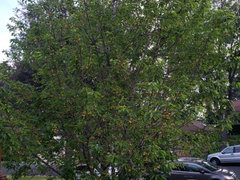
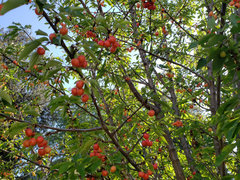
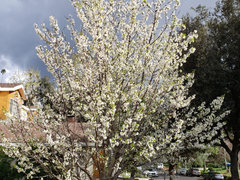
James
3 years agoGreat write-up, 1058! If you want to get pollinators to get the rest of your Royal Lee crop, here are some potential options. I am listing everything in order of bloom:
Minnie RoyalRoyal Crimson (a few days to a week after MR)
Royal Lee (started a few days after MR in the manner you described, bottom up, but went on over a month)
Lapins (started 1 week after MR, had extended bloom over a month)
Brooks (started a few weeks after MR, but did overlap with RL)
Governor Wood (started a few weeks after MR)
Coe's Transparent (started a few weeks after MR)
Royal Rainier (4 weeks after MR, not as good an option, at least this year)
All of these had some bloom overlap with Royal Lee. If you did Royal Crimson and Lapins, you are probably good to go. The other ones I put on there are just experiments. I am in inland San Diego, near Lake Hodges.HU-111905664
3 years agoJames, how many chill hours do you get in average please. I've never considered anything higher than the Zaiger's varieties chill requirements.
James
3 years ago300 hours. I am just experimenting for fun. I do this on other stone fruit and have had some success. Mostly failures but the successes have been delicious! Lapins is definitely reasonable, check out Laguna Hills nursery website and YouTube channel for ideas. Keep in mind I am inland. Southern California coastal is a different climate. The distinction doesn’t feel all that different when you drive 10 miles, but I have noticed a difference on fruit trees, having lived in both locations.
HU-111905664
3 years agolast modified: 3 years agoWonderful! I try to do the same myself. I grafted few high chill plum varieties and one of them hasn't even broken dormancy yet. I wonder if it ever will.
HU-295720709
3 years agoMinnie royal giving me just a few but it’s something, royal lee without fruit set and royal crimson giving me lots of growth but no flowering this year. Sunset 22. 10a
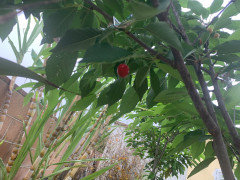
socalnolympia
3 years agolast modified: 2 years agoA bunch of small cherries has appeared on my Minnie Royal
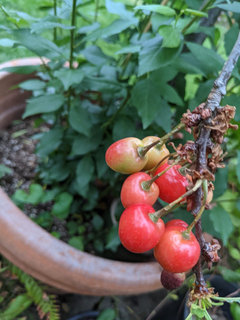
solid zone 10 (on border between 10a/10b) south of Irvine.in case the picture stops working, I'll describe them to you. they are not all the way plump and fully developed yet, but do already have much more of a red blush than ranier cherries. (there are 9 fruits) April 23, 2021
I saw a few small cherries form on another one of the Minnie Royal trees last year. However, still no cherries on my Royal Lee trees. The pollination seems to be working though, even though the trees are not close together and don't have too many blossoms.
The Royal Lee has grown fairly well now and looks like it has more balanced growth, though still has not grown as vigorously as a tree in a colder climate would.
Rebecca Reynolds
2 years agoI live in San Diego. I got 5 cherries last season between my 5 year old. Minnie and Lee .
2 cherries the year before.
I guess I am not getting many chill hours....Last winter, The nursery man told me to put a bag of ice on the roots.
I spread a big bag at the base of each tree and covered the ice with a mound of straw. Took a couple days to melt.
This summer, 50-60 cherries on my Minnie- 25 on my Lee!
He was correct! Excellent!
socalnolympia
2 years agoAnother thing that can sometimes be very helpful is shade cover during the winter to reduce the temperature. It's not just a matter of how much cold the trees are exposed to, but how much consecutive cold. Just a few warm winter days can really detract from chill accumulation.
Steven Gwynne
2 years agoI live near LAX and have a Royal Lee and Minnie Lee. The Royal Lee is a big vigorous tree entering its 5th year. My first Minnie Lee died in its 3rd year, but its replacement is now 2 years old and also vigorous. There is a very brief overlap in their flowering periods. Both trees start blooming in February. The Minnie Lee finished blooming in early March, while the Royal is just finishing end of April. The Minnie Lee was quite productive, the Royal Lee less so. Pity, because the Royal Lee produces better fruit. There is a new self-fertile low cherry called Royal Crimson which also serves as a pollinator whose bloom period reportedly spans Minnie Lee and Royal Lee. I drove to the Green Thumb nursery in Simi Valley to find them, but I bought and planted two Royal Crimsons last year. They are still practically twigs, but one of them actually bloomed and produced a single cherry.
Quick Cookie
2 years agoHas anyone had experience with cherries shot hole disease ? I live in zone 10B
socalnolympia
2 years agolast modified: 2 years agoI can provide another little update. There is one single cherry fruit on the Royal Minnie which is grafted onto Bing. The tree is pretty big, and the upper grafted portion is in full sun and fully exposed. The cherry fruit is not all the way ripe, but looks like it will ripen.
May 29, 2021
It is looking like these trees are very reluctant to fruit here. But they might if the tree reaches a very big size and there was a colder winter than usual.
The Bing part of the tree has put out much fewer leaves than the Royal Minnie grafted part, and the leaves also look a little smaller as well. Much of the Bing part of the tree is barren without leaves, but the bud areas are still green. It's obvious the Bing (being a high-chill requirement variety) did not leaf out as vigorously in this climate.



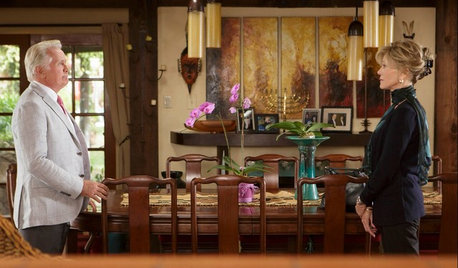


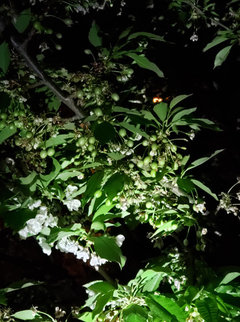
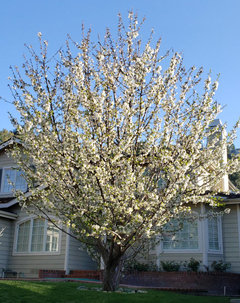



HU-697401058